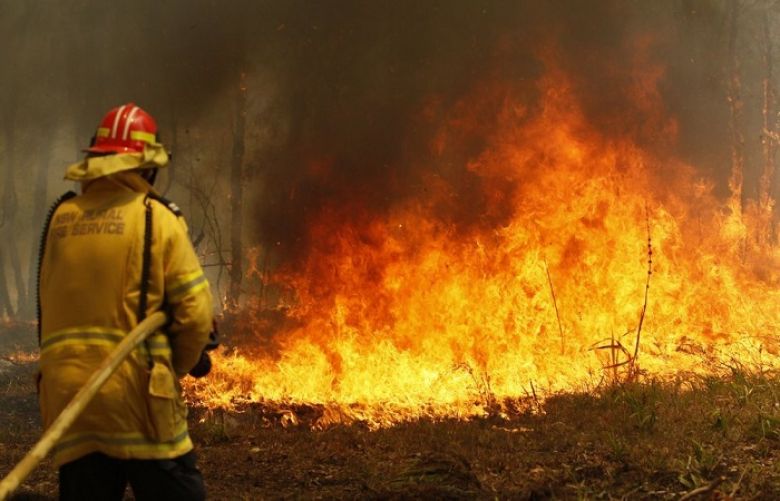Wildfires razing Australia’s drought-stricken east coast have left three people dead and several missing, more than 30 injured and over 150 homes destroyed, officials said on Saturday.
Around 1,500 firefighters were battling more than 70 fires across Australia’s most populous state, New South Wales, with the most intense in the northeast, where flames were fanned by strong winds, Rural Fire Service Commissioner Shane Fitzsimmons said.
A woman who was found unconscious and with serious burns on Friday near Glen Innes died in a hospital, he said.
Her daughter-in-law Chrystal Harwood identified the victim as 69-year-old grandmother Vivian Chaplain, who was alone in her house in the small community of Wytaliba when it was engulfed in flames.
“I was the last one to speak to her. She was in an absolute panic. She said: ‘We’re on fire. There’s fire everywhere. I need the boys here now',” Harwood told Nine Network television of their final phone call.
“Before I even got to tell her to just get out, she’d hung up on me. I couldn’t get back through to her. I tried so many times,” Harwood said. “She was amazing. She was such a strong, loving woman.”
On Friday, Harwood made a desperate plea on social media for someone to come to Chaplain’s rescue.
“Viv is alone can someone help, anyone please [...] boys are on the way down if they can get through,” Harwood posted. "The RFS can’t get to her they are trying [...] the road down is a tunnel of fire.”
Firefighters found another body on Saturday in a burned car near Glen Innes, a victim of the same fire, officials said. The local man’s name has not been released.
A third body was found on Saturday afternoon in a burned building at Johns River, north of Taree, a police statement said. That victim died in a fire hundreds of kilometers from Glen Innes.
Another seven people have been reported missing in the vicinity of the Glen Innes fire, Fitzsimmons said.
“We are expecting that number (of missing people) to climb today,” he said. “There are really grave concerns that there could be more losses or indeed more fatalities.”
More than 30 people including firefighters received medical treatment for burns and one patient had cardiac arrest, he said.
At least 150 homes had been destroyed since Friday, and damage assessment teams had yet to reach some devastated areas, a Rural Fire Service statement said. Residents could not yet return because of the dangers of fire, smoke and loose asbestos in the rubble, the statement said.
Hundreds of people evacuated their homes along a 500-kilometer swath of the eastern seaboard from the Queensland state border south to Forster.
Forster is a town 300 kilometers north of Sydney, Australia’s largest city. Many spent the night in evacuation centers, while some slept in cars.
In Queensland, around 50 wildfires were raging on Saturday. At least one house was lost, a firefighter suffered a broken leg and 6,000 residents were evacuated from three communities in the state’s southeast, police said.
Prime Minister Scott Morrison warned Australia to expect more bad news from the fire zones. His warning came before the third victim was confirmed.
“The devastating and horrific fires that we have seen particularly in New South Wales but also in Queensland have been absolutely chilling,” Morrison told reporters in Sydney.
The Insurance Council of Australia declared the wildfire crisis a “catastrophe”, meaning insurance claims will be given priority.
In Taree, more than 300 people evacuated overnight to a social club, including Club Taree’s chief executive, Morgan Stewart.
“It was pretty scary,” Stewart said. “We’re hearing lots of stories of lost houses, lost property, goods and effects, animals, land. It’s going to be horrific, I think.”
Peter Lean spent the night on the roof of his house in the town of Wallabi Point, extinguishing burning embers carried on strong winds.
“I’ve never seen the sky so red since 2000,” Lean said. “We’ve got winds blowing, they’re circling, it’s like a cyclone.”
The fire danger reached unprecedented levels in New South Wales on Friday, when 17 fires were burning at the most extreme danger rating known as the Emergency Warning Level.
“I can only recall a figure of less than 10 that we (previously) got to, which was an extraordinary event in years past,” Fitzsimmons said.
Between two and five fires were burning at the highest danger rating during Saturday.
The annual Australian fire season, which peaks during the Southern Hemisphere summer, has started early after an unusually warm and dry winter.







